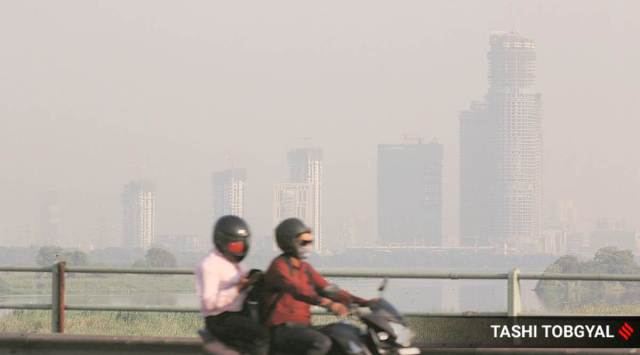- India
- International
Delhi’s air quality ‘poor’;wind direction shift may improve it
The city recorded an overall AQI of 240 at 10 am. The 24-hour average AQI was 216 on Sunday and 221 on Saturday.
 Director of National Institute of Urban Affairs (NIUA) Professor Jagan Shah gave an elaborate presentation on air quality, its impact on health and transit-oriented development. (File)
Director of National Institute of Urban Affairs (NIUA) Professor Jagan Shah gave an elaborate presentation on air quality, its impact on health and transit-oriented development. (File)The air quality in the national capital and adjacent areas was recorded in the “poor” category on Monday morning, with concentration of fine particulate matter “PM2.5 and PM10” increasing to the highest recorded levels this season so far.
However, the Ministry of Earth Sciences’ air quality monitor, SAFAR, said the air quality index (AQI) was likely to improve slightly in the coming days due to a change in the wind direction.
The city recorded an overall AQI of 240 at 10 am. The 24-hour average AQI was 216 on Sunday and 221 on Saturday.
The AQI in Jahangirpuri (301) and Vivek Vihar (316) hit the “very poor” category.
An AQI between 0 and 50 is considered ‘good’, 51 and 100 ‘satisfactory’, 101 and 200 ‘moderate’, 201 and 300 ‘poor’, 301 and 400 ‘very poor’, and 401 and 500 ‘severe’.

PM10 levels in Delhi-NCR stood at 242 microgram per cubic meter (g/m3) at 9 am — the highest this season so far, according to CPCB data. PM10 levels below 100g/m3 are considered safe in India.
PM10 is particulate matter with a diameter of 10 micrometers and is inhalable into the lungs. These particles include dust, pollen and mold spores.
The levels of PM2.5 “finer particles which can even enter the bloodstream were 106g/m3. PM2.5 levels up to 60g/m3 are considered safe.
Delhi’s air quality had turned poor on Wednesday, the first time in since June 29, with the Central Pollution Control Board recording a 24-hour average AQI of 215.
SAFAR said as many as 448 farm fires were observed in Punjab, adjoining Pakistan, Haryana and Uttar Pradesh which impacted Delhi’s air quality on Sunday.
However, the wind direction will change from northwesterly to southeasterly and the impact of farm fires will reduce, it said.
On Monday morning, Delhi’s minimum temperature settled at 19.4 degrees Celsius. The maximum wind speed was 4 kilometers per hour.
Low temperatures and stagnant winds help in accumulation of pollutants near the ground, affecting air quality.
With Delhi-NCR bracing for months of poor air quality, experts have warned that high levels of air pollution can aggravate the COVID-19 pandemic.
High level of air pollution in Delhi is a year-round problem, which can be attributed to unfavourable meteorological conditions, farm fires in neighbouring regions and local sources of pollution.
According to an analysis by the Council on Energy, Environment and Water, a Delhi-based think tank, transportation contributes the most — 18 to 39 percent — to Delhi’s air pollution.
Road dust is the second largest source of air pollution in the city (18 to 38 percent), followed by industries (2 to 29 percent), thermal power plants (3 to 11 percent) and construction (8 percent).
This year, the Delhi government has launched a massive anti-air pollution campaign — Yuddh Pradushan Ke Viruddh’ — which is being led by Chief Minister Arvind Kejriwal and Environment Minister Gopal Rai.
A “green war room” with a 10-member expert team has been set up at the Delhi Secretariat to monitor the steps being taken to deal with high levels of air pollution in winters.
The environment department has also taken stern action against project proponents at large construction and demolition sites flouting dust control norms.
The government will also start the spraying of “Pusa bio-decomposer” solution in non-basmati rice fields in the national capital, starting Tuesday.
The solution, experts say, can turn the stubble into manure in 15 to 20 days and therefore, can prevent stubble burning.’
Starting October 15, stricter measures to fight air pollution will also come into force in Delhi and its neighbourhood as part of the Graded Response Action Plan, which was first implemented in Delhi-NCR in 2017.
Apr 19: Latest News
- 01
- 02
- 03
- 04
- 05





























